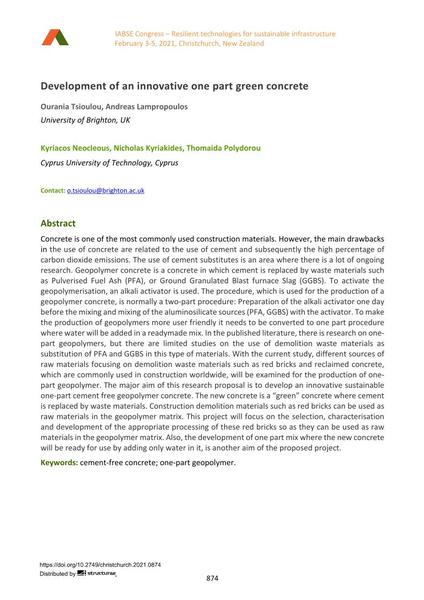Development of an innovative one part green concrete

|
|
|||||||||||
Bibliographic Details
| Author(s): |
Ourania Tsioulou
(University of Brighton, UK)
Andreas Lampropoulos (University of Brighton, UK) Kyriacos Neocleous (Cyprus University of Technology, Cyprus) Nicholas Kyriakides (Cyprus University of Technology, Cyprus) Thomaida Polydorou (Cyprus University of Technology, Cyprus) |
||||
|---|---|---|---|---|---|
| Medium: | conference paper | ||||
| Language(s): | English | ||||
| Conference: | IABSE Congress: Resilient technologies for sustainable infrastructure, Christchurch, New Zealand, 3-5 February 2021 | ||||
| Published in: | IABSE Congress Christchurch 2020 | ||||
|
|||||
| Page(s): | 874-880 | ||||
| Total no. of pages: | 7 | ||||
| DOI: | 10.2749/christchurch.2021.0874 | ||||
| Abstract: |
Concrete is one of the most commonly used construction materials. However, the main drawbacks in the use of concrete are related to the use of cement and subsequently the high percentage of carbon dioxide emissions. The use of cement substitutes is an area where there is a lot of ongoing research. Geopolymer concrete is a concrete in which cement is replaced by waste materials such as Pulverised Fuel Ash (PFA), or Ground Granulated Blast furnace Slag (GGBS). To activate the geopolymerisation, an alkali activator is used. The procedure, which is used for the production of a geopolymer concrete, is normally a two-part procedure: Preparation of the alkali activator one day before the mixing and mixing of the aluminosilicate sources (PFA, GGBS) with the activator. To make the production of geopolymers more user friendly it needs to be converted to one part procedure where water will be added in a readymade mix. In the published literature, there is research on one- part geopolymers, but there are limited studies on the use of demolition waste materials as substitution of PFA and GGBS in this type of materials. With the current study, different sources of raw materials focusing on demolition waste materials such as red bricks and reclaimed concrete, which are commonly used in construction worldwide, will be examined for the production of one- part geopolymer. The major aim of this research proposal is to develop an innovative sustainable one-part cement free geopolymer concrete. The new concrete is a “green” concrete where cement is replaced by waste materials. Construction demolition materials such as red bricks can be used as raw materials in the geopolymer matrix. This project will focus on the selection, characterisation and development of the appropriate processing of these red bricks so as they can be used as raw materials in the geopolymer matrix. Also, the development of one part mix where the new concrete will be ready for use by adding only water in it, is another aim of the proposed project. |
||||
| Keywords: |
cement-free concrete one-part geopolymer
|
||||
